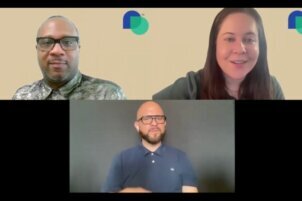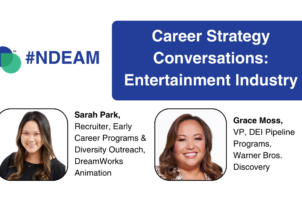Disability Belongs™’ Senior Director of Leadership and Workforce Development Kevin McCloskey spoke with Taryn Williams, the Assistant Secretary for Disability Employment Policy at the U.S. Department of Labor. Their conversation focused on National Disability Employment Awareness Month!
Transcript
Kevin McCloskey: All right! Welcome to Disability Belongs™’ conversation for NDEAM. We’re very excited for our guest today. So would you mind — please introduce yourself and provide a visual description of yourself as well?
Asst. Sec. Taryn Williams: Absolutely, and thank you Kevin for for having me. I’m honored to be here. My name is Taryn Williams, and I have the privilege of serving as Assistant Secretary for Disability Employment Policy. And in that role, I lead our Office of Disability Employment Policy or ODEP — O D E P. And for a visual description I am a black woman with shoulder — let’s call it shoulder length curly hair, and I’m wearing a dark blue sweater and a green scarf today.
Kevin McCloskey: Awesome, thank you for that. And I’m Kevin McCloskey. I’m the Senior Director of Leadership and Workforce Development at Disability Belongs™. I am a white male with black hair with a little bit of sprinkled gray in there. I’m in my early 40s. So thank you again for coming here today. So we’ll start with you know — what really motivated you to pursue a career focused in disability employment, and tell us how your role as Assistant Secretary influenced your approach to this work?
Asst. Sec. Taryn Williams: Yeah that’s a great question. I would say throughout my career, I’ve always been drawn to service and and working in roles that allow me to in some way improve the lives of others. And what motivated me to really embrace disability employment is my own experience. I grew up with a digestive disease, something I had very early on as a child. I then in adulthood acquired arthritis. And I did when I first started in the workforce and continue to today really need accommodations to be able to thrive in my career. And so, disability inclusion and, really, workplace disability inclusion is something I care deeply about. It’s been a defining thread over the last almost two decades of my career. I’ve been fortunate to have what I’ll call peer mentors, folks who are of the disability community who have been essential to me as I’m on my own disability journey. And they’ve also been essential in helping me to understand the role that the Americans with Disabilities Act or the ADA — that it plays in all of our lives. So that is sort of my own story, and it very much impacts how I think about the work that we do as an agency, and how I think about the work as a leader with a nonapparent disability today.
Kevin McCloskey: Thanks for that. And I know as we — you know, we’re in NDEAM now, right, so we’re in October, and you know, there’s been a lot of progress over the years. You mentioned the ADA. There’s been a lot of progress over the last 10 years or so I’d say as well. But what are some of those, you know, key challenges you’ve encountered in advancing disability employment over the years, and how have you addressed them as well?
Asst. Sec. Taryn Williams: Yeah, that’s a good question, certainly something we think a lot about as an agency. I would say even after more than three decades of the ADA, we know and see that negative attitudes and, you know, harmful workplace cultures persist. And they persist and impact how inclusive workplaces are to jobseekers and workers with disabilities. I think there are a lot of factors that affect those attitudes and cultures. One is stereotyping — so where people with disabilities may be presumed to be helpless or unable to care for themselves, or unable to make their own decisions. We also see condescension. Opportunities may arise, but there might be a perspective that people with disabilities need to be overprotected or coddled because of misperceptions. And then lastly, I would point to a lack of understanding and awareness about disability. I mean, contrary to all of those negative attitudes, we know that every day people with disabilities can and do make important contributions to our workplace. They’re showing up to work every day, they are thriving. And part of our work as an agency is to constantly share that message and to share resources, be they policies or practices, that help businesses and others recognize the value that employees with disabilities bring to the workplace.
Kevin McCloskey: Yeah, and you mentioned awareness, right? So NDEAM is National Disability Employment Awareness Month, right? So created a lot of awareness — you’re right, there’s a lot of education to be had. But how can we get past just that awareness, past that education, and for this year’s NDEAM, how could employers actually take action to achieve success when it comes to disability employment?
Asst. Sec. Taryn Williams: Yeah — I’m glad you brought up awareness, because you know from — ODEP was founded or created by Congress a little more than 20 years ago. And we were created to bring a particular focus across systems, policies, and agencies with that explicit purpose of increasing not only the number of employment opportunities for people with disabilities, but also the quality of those opportunities. So our work as a non-regulatory agency is very much focused on policy and practice at the national or the federal and state and local levels. But underpinning that has always been efforts around education and awareness building. We’ve done that for years through our public service campaign, like the campaign for disability employment. We also do it through National Disability Employment Awareness Month, or NDEAM. You know, every October we have an opportunity to — and a platform to let those across the country know just how valuable the contributions of people with disabilities are to the workplace. It’s also an opportunity for us to spotlight what is working well. And so our goals in October for NDEAM are really to celebrate workers with disabilities, to celebrate the contributions, the talent, the perspectives that they bring to America’s workplaces and to our economy, and also to communicate the message that NDEAM officially takes place in October, or sometimes I’ll say it seems to start in late September, but this is a message that we are committed to upholding all year long. We want to ensure that disabled workers have access to good jobs in every month of every year. And one of the fun things about my job is I get to work with our team and with a number of external stakeholders in identifying what the theme will be for NDEAM each year. And this year’s theme is “Access to Good Jobs For All.” That goes back to what I was saying earlier about us not just focusing on the number of jobs that are available — although that matters, we want to close that gap that exists between people with disabilities and people without disabilities in the workplace. But we also believe that those should be good jobs. And it speaks to our commitment and our understanding as a department, as an Administration, that good jobs change lives. We want to make sure that all workers, including workers with disabilities, are prepared for good jobs, that they are able to obtain good jobs, they succeed in those jobs, critically they’re able to grow and advance in their careers. And for us, it’s really important to define what we mean when we say a good job. Earlier in September, the President, President Biden signed what we refer to as a good jobs executive order. And it promotes strong labor standards. It promotes family sustaining wages. It promotes workplace safety. Those are what we believe are elements of a good job, and it’s what we believe every person with a disability should have access to. So that is our focus, not only in October and with NDEAM and the theme that we’ve selected for this year, but also our focus throughout the year.
Kevin McCloskey: That’s great, yeah. A question I typically get from employers is, like, what jobs can people with disabilities do, which I think is one of the silliest questions you can ask, because people with disabilities can do any job out there. Again — I’ve seen success from — a warehouse, to scientists, to all over the place. People with disabilities can do the job that they’re a good fit for, right? So as a disability community — through your work with NDEAM, can you kind of tell me about some of those success stories you mentioned, like — spotlighting some of those successes?
Asst. Sec. Taryn Williams: Sure, sure. And let me just say I totally agree with you. In my mind, our work, our collective goal will be met when people with disabilities are not just represented in the workforce, but also represented at every level in a workplace, that they’re represented across occupations and sectors, in jobs, in offices, jobs in the trades, jobs where, again, they’re able to earn and to thrive and live independently. And as we think about NDEAM and we start our preparations each year, we think about the the spirit of NDEAM really being at the grassroots level. There are any number of celebrations and observances in the workplaces and in communities across the country. We’ve seen a lot of creative things take place. It seems to grow and evolve every year. Many companies use it as a time to host events, such as panels, or to highlight employees with disabilities in their newsletters or through other channels. I’ve heard of and often see companies using NDEAM to launch a new disability related Employee Resource Group, or an affinity group. I mention that one in particular because so much of our work and thinking about what does it look like to have an inclusive workplace is in recognizing the role that not only the job seekers with disabilities, but really every colleague has in making their workplaces inclusive. And ERGs, as they’re sometimes called, can play a key role in that. And they do, not just in NDEAM. We’ve also seen success stories with States with Vocational Rehabilitation or VR agencies or other disability service providers using it as an opportunity to recognize their employer partners. I know that New Hampshire and Virginia — those are two states — or a state and a Commonwealth who do that. And these are often the types of events where they’re championing the businesses that are doing a great job on disability inclusion. And you know, the way we message has changed and evolved in the years since NDEAM first launched. NDEAM has been around for a long time, has sort of gone through several iterations, but what we’ve seen over the last decade is that social media has played a larger and larger role. Of course, it’s not surprising that people and companies share hashtags with the NDEAM spirit. They use it as an opportunity to spotlight what their efforts are as a company. Individuals use it because it offers a platform to talk about the experiences of people with disabilities in the workplace. And we also do that in the federal government. I really probably cannot count at this point how many agencies reach out as they’re planning their NDEAM-related events. It often leads to a really robust NDEAM calendar. And I’ve had the honor, as have many of my colleagues, to speak at many different events hosted by federal agencies over the years. And we are thrilled that there is increasing interest and engagement from our federal partners on how they can be more inclusive. That matters. I believe that the federal government and all levels of government can be models for how we recruit, hire, retain, and advance people with disabilities. I believe that about the private sector too, because as we said earlier, people with disabilities should be represented at every level in the workplace, in every occupation, and in every sector.
Kevin McCloskey: That’s great. And I was just at an inclusion call — discussion last week, and it was all about DEI and the work that’s being done out there. And most of the individuals who are HR professionals in the room said they — their efforts were were going very well. And I said — how many of your efforts actually include disability? And everyone put their hand down, right? So I — October is a really great time to start, take that first step when it comes to disability inclusion in the workplace. You know, it’s a great opportunity to be educated — have some lunch and learns, really take that first step to educate, and then kind of take those opportunities to grow from there. I think a lot of employers sometimes are afraid of taking that first step. So it’s very important. Another thing I’ve seen is — when it comes to inclusion, a lot of employers share a lot of great data. But again, disability data is sometimes not there. And I’ve talked to employers who have great numbers when it comes to hiring people with disabilities, but still not shared. So again, it really is a great time for employers to kind of take that first step which is — in October, but also it will go and translate throughout the entire year. So I appreciate — those tips for employers. Tell us a little bit about how ODEP engages with and incorporates some of the feedback from actual individuals with disabilities to shape your policies and programs.
Asst. Sec. Taryn Williams: Yeah that’s — a great question. I want to touch on something you said just now about the data. Sort of a sideline into how important disability data and disability employment data are to the work that we do. I believe strongly as agencies, as workplaces, we should have measures that help us understand what is happening in the workforce for job seekers and people with disabilities. And we absolutely champion private sector employers doing this too, really taking that deep dive into their hiring practices, into their data about retention, so they can understand how people with disabilities are fairing in the workplace, ensuring that they’re able to progress in their careers. I think that — to get to your question about involving and engaging people with disabilities, I often will go back to a saying that is quite common in the disability community: “nothing about us without us.” I have seen over the last few years, it evolved to being “nothing without us.” And I would say that what we know about inclusive workplaces, what we know about the practices that lead to success for job seekers and people with disabilities — that’s informed by workers themselves. And I believe that employers and hiring managers or other individuals who are seeking to make their workplaces more inclusive — they need to start with individuals with disabilities in those efforts. I want to be careful to say that when they’re engaging in those efforts, that doesn’t mean sort of work that isn’t compensated and sort of tell us everything that we need to fix, because that shouldn’t fall on an individual or sort of be a burden to an individual to fix everything that might exist about a workplace. But they should absolutely be — have their perspectives recognized and incorporated into decisions that employers or agencies are making about those workplaces. One concrete example of that might be the work that we see in practices around accommodations. We know that reasonable accommodations are at the heart of disability inclusion, and they are critical at every phase in the employment life cycle, from onboarding to advancement. And organizations should be responsive to accommodation needs of all of their employees, and that spirit of inclusion should be demonstrated at every level, starting with leadership. And we as leaders should be ready, willing to hear feedback about the process and how we can take additional steps to ensure that practices like our practices related to reasonable accommodations — that they are truly meeting the needs of individuals. We shouldn’t make it hard, right? We understand as employers, we understand in the workplace that individuals want to be able to thrive. And that starts with having processes that really give them the opportunity to do so, like reasonable accommodations processes.
Kevin McCloskey: That’s a great point. And October, again, is a great place and time to actually look at your accommodation process — actually as an individual, go through it, request one when you’re going through a job application to your own company, see how it’s working internally. Because I’ve seen 9.9 out of 10 times the accommodation process isn’t working how it should. Like you said, a lot of — it should be interactive, it should be helpful, it should be there to make — empower the employee to be the best they can, and just like you do with everyone else. So great, excellent. I do appreciate your time. I want to know — tell us what you particularly or ODEP is doing in October, and what you’re really excited about.
Asst. Sec. Taryn Williams: Yeah, oh, I’m excited about a lot of different things. You know, I already talked about the spirit of of NDEAM, but also — acknowledging that it is an opportunity to celebrate work that we do all year long. We have a focus right now — we’re not unusual in this, but we’re thinking about how AI or artificial intelligence is going to or is already impacting the workplace. Recently, we launched a really comprehensive resource around AI and a hiring framework, one that is meant to lay out, regardless of where you sit — in an organization, considerations, both legal or regulatory or otherwise for the — everything from conceptualization, to procurement or deployment of artificial intelligence. I am an optimist, so I believe that there is so much potential and promise in AI and what it can mean for people with disabilities, not only in the workplace but in every setting. I’m also a realist, and understand that if we aren’t careful and thoughtful or deliberate in our work around AI, we might further disadvantage job seekers with disabilities. So I’m excited to be able to talk about our work in AI. I am excited to spotlight a number of resources that we leverage throughout the year. And I’ll just mention a few. One — because we’re talking about job accommodations, I’d be remiss if I didn’t talk about our Job Accommodation Network or JAN. JAN is the leading source of free and confidential one-on-one assistance in accommodations. You were saying — as employers or leaders, we should go through the process. And when I talk about the JAN, when I recommend it, I have used it. I’ve used it as an employee myself in helping me to better understand my evolving accommodation needs. I’ve used it as a manager as I sought to understand how to provide accommodations — the best accommodations to employees and to be a part of that interactive process. And I recommend it no fewer than two or three times a week. We also have another resource that is so critical to the work that we’re doing with employers — in partnership with employers who really are sharing with us what works. And our Employee Assistance and Resource Network, EARN as we call it, is — has just a wealth of resources. It’s — they’re technical assistance resources. They are free. They cover a range of topics that we know are front of mind for employers — mental health, neurodiversity, hybrid work or the return to work. There’s so many practices that are really covered and considerations for businesses of all different sizes. So I’m excited to be able to talk about those. And often we’ll come out of October wishing that there were more days in the month, because we want to leverage that excitement and attention and visibility that we have to disability employment every — every single month. So that — that’s just a snapshot of what I’m excited about, but really, it’s a reflection of the commitment of my colleagues here at ODEP, the work that they do day in and day out to ensure that we are helping to foster workplaces that are inclusive of people with disabilities.
Kevin McCloskey: That’s great, thank you so much. We’re actually doing a joint webinar with the Job Accommodation Network in October, so visit our website for more information on that. Assistant Secretary Williams, thank you so much for your time, I appreciate it. Always great to talk to you. I hope you have a great October and look to collaborate soon. Thank you.
Asst. Sec. Taryn Williams: Thank you. I appreciated being here and happy NDEAM.
Kevin McCloskey: Thank you, thank you.






